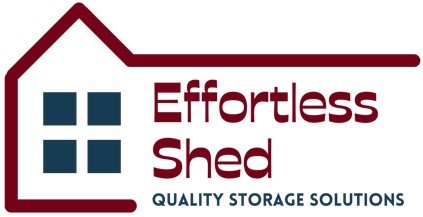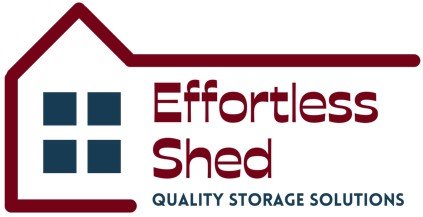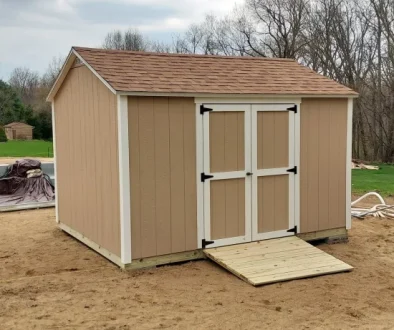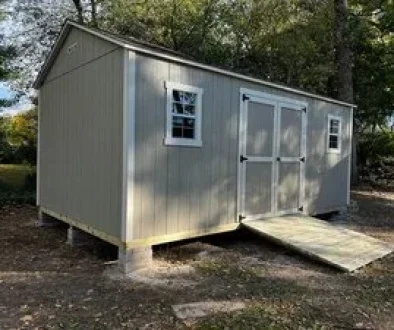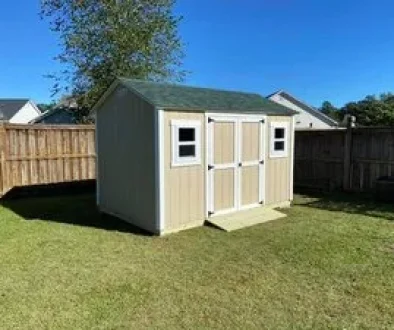What to know before buying a shed?
Introduction
Are you searching for the perfect shed to maximize storage space in your backyard? Before buying a shed, you should consider all the different types, shapes, and sizes of sheds available.
Don’t let this overwhelm you; use it to discover the kind of shed that best suits your unique needs. In this blog post “what to know before buying a shed”, we will explore what factors should be considered before buying a shed so that you can end up with a structure that looks great and provides optimal functionality.
We’ll discuss things like size, materials used, cost considerations, and much more — essential knowledge if you want to make an informed decision about buying a shed! Keep reading to get all the insight needed to ensure your choice is one lead satisfied.
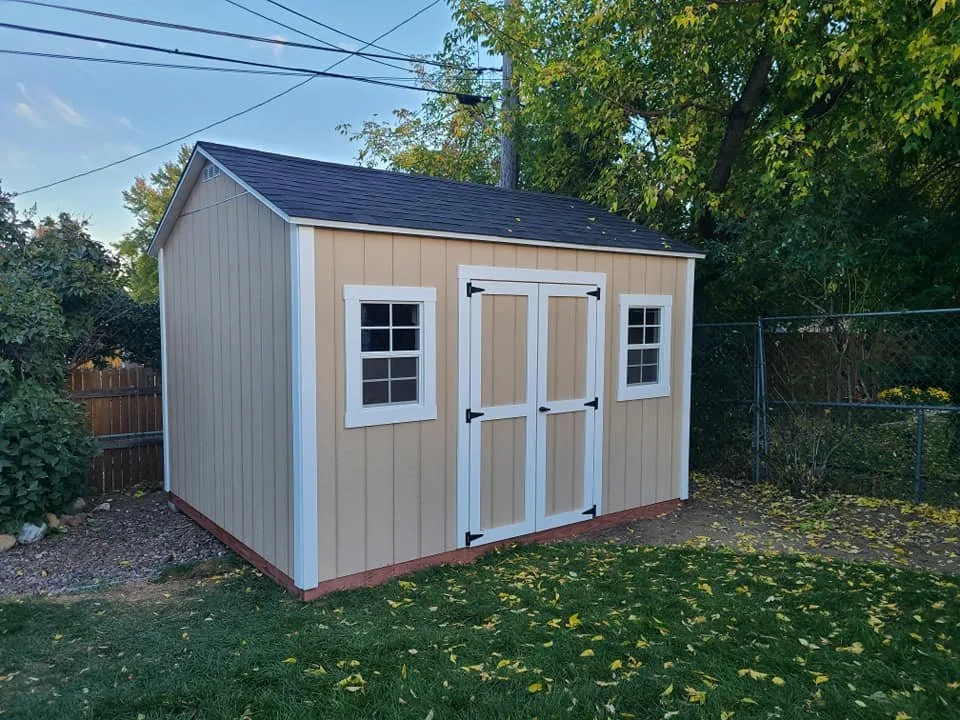
What To Know Before Buying a Shed
Before you buy a shed, there are a few factors to consider that are the followings:
1. Consider The Purpose Of Your Shed
It is important to first consider the purpose of your shed. Are you looking for a place to store tools and garden equipment or even create an outdoor living space? Once you have determined the shed purpose above, you can decide on the type of shed that best suits your needs.
Some Common purposes of a shed are the followings:
Storage shed
This is the most common type of shed and can be used to keep items such as gardening tools, lawnmowers, bicycles, outdoor toys, etc.
Garden Shed
These two sheds are perfect for storing larger garden equipment such as lawnmowers, shovels, rakes, and hoses. Most garden sheds also have windows that allow you to enjoy the outdoors while working on projects in your workshop.
Pool House Shed
A pool house shed may be in order if you want to spend more time at the pool. This shed typically has plenty of space for lounge chairs, umbrellas, and other pool accessories.
Hobby Sheds
If you have a hobby like painting or woodworking, a hobby shed may be just what you need. These sheds provide plenty of storage buildings with space to work on your projects peacefully.
Playhouses
Kids love having their playhouse, and many styles are available today. From wooden cabins to plastic playhouses, there is something for every kid!
The shed’s purpose will determine the next procedure.
2. Decide The Location Of The Shed
After deciding on the shed’s purpose and understanding all the building codes and requirements, you must decide on a suitable location for installing the shed.
Factors for considering the location of the shed are the following:
Accessibility
The shed should be in an easy-access location, even when the weather is unfavorable, and you must bring bulky items inside.
Privacy
What are the rules of your community or neighborhood regarding sheds? Will they block any views from neighboring houses? Make sure you select an area that respects the privacy of others.
Space
If necessary, ensure enough space around your shed for future expansion or maintenance work.
Safety
Consider safety hazards such as overhanging branches or busy roads when setting up a shed in the yard.
Sunlight
Sheds need sunshine during winter to stay warm and dry during rain and snowfall. Position it in a spot that gets maximum sunlight, but not too much, as it may get overheated.
Slope
Make sure the location of your shed has enough flat ground for better support and easier construction work. Sheds built on slopes might require additional foundation work, which can be costly.
Drainage
Avoid putting your shed near water sources like ponds, streams, or rivers to minimize the risk of flooding or dampness inside the shed due to seepage from these bodies of water.
Distance
Consider whether you need easy access to your shed from other parts of your house, such as storage space or garden supplies like wheelbarrows and lawnmowers. The location should also provide easy access for delivery vehicles if necessary.
Stop Guessing – Calculate Your Perfect Shed Budget!
Our effortless buying process makes it easy to customize your storage shed.
Compliance with local regulations
It is important to confirm whether local legislation permits the construction of a shed and what types of sheds are allowed in your locality.
Considering the above factors, you can ensure your shed is located in a spot that meets both functional and aesthetic requirements while providing maximum convenience and safety. The location should be strong and sturdy enough to hold the weight and size of the shed.
3. Budget For Buying The Shed
Before you start shopping for a shed, you must know your budget. What can you realistically afford? What kind of materials, sizes, and features do you need that fit within your budget? Look at the prices of sheds online or in stores and make sure to factor in any additional costs, such as delivery or installation fees. This will help narrow your options and get you closer to finding the perfect shed for your needs.
4. Consider The Size of the Shed
When buying a shed, size is one of the most important factors. It would be best to consider what you will store in your shed and how much space you have in your yard or garden. It is essential to measure the area in which you plan on placing your shed so that you can ensure.
Factors determining the size of the shed are as follows:
Type of items you plan to store
Ensure the shed has enough space to accommodate all your items while allowing room for expansion.
Type of access you need
if you plan on storing large equipment or vehicles in your shed, you must choose a model with larger doors and drive-through access.
Size of your yard or garden
Consider how much space you have for a storage building the shed, and make sure it fits comfortably within the boundaries of your outdoor area.
Height clearance is needed for any stored items.
If tall items need storage in your outdoor storage shed, ensure enough space to fit comfortably.
Before buying a shed, it’s important to measure the area in which you plan to place your shed and consider any future needs, such as storage requirements and access.
Consider the size of the right shed very carefully to meet all your needs while also fitting comfortably within your outdoor space. Keeping these factors in mind will help ensure that you get the perfect shed for your home.
5. Do you need a permit to build or Install a shed
After considering the purpose, location, and size of the shed you plan to build, it’s important to determine if you need a permit for the installation.
Obtaining a permit may vary by city or county regulations, so it is important to check for local requirements before installing your shed. Depending on where you live, permits can cost anywhere from a few hundred to a couple of thousand dollars.
When applying for a permit, you’ll likely be asked to provide proof of ownership or legal right-of-way on the property where you are constructing the shed. You will also need to apply specific information about your proposed shed, such as its size and purpose and details of any existing structures that could be affected by the new shed placement construction.
Detailed blueprints or illustrations of the shed’s design may also be required.
In some cases, you may be able to build a shed without obtaining a permit. Generally, if the shed is less than 200 square feet and does not include plumbing or wiring, it may be exempt from permitting in some locations.
However, it is important to double-check local building codes and regulations before building to avoid potential fines or having to tear down an unpermitted structure.
It can also be helpful to contact your local government office for advice on any specific regulations that are in place for sheds and other outbuildings in your area. Knowing what permits are needed and understanding any restrictions will help ensure your new construction project meets all requirements so you can complete your shed without any issues.
By checking permit requirements before starting a new shed construction, you can ensure that your project is completed on time and with minimal complications. Doing so will also help protect your investment by ensuring it meets all local regulations for the safe and legal construction of a shed.
6. Choose The Right Foundation Of The Shed
When buying a shed, a proper foundation is key to ensuring the shed’s shopping structure will last for years.
The most common foundation types of foundation are the followings:
Concrete slab
A concrete slab is a simple and cost-effective foundation option, providing a flat and level base for your shed. However, ensuring the soil is leveled before pouring the concrete is important. Once complete, this foundation can last for decades without any additional maintenance required.
Wooden skids
These are wooden beams that lay directly on the ground and provide support for your shed floor. Wooden skids are much easier to set up than building a full concrete slab but will need to be replaced every few years due to rot from moisture in the soil.
This foundation is suitable only for smaller sheds and outdoor structures, as larger structures require more stability and support than skids.
Concrete piers
You can also use concrete blocks or piers to support your shed. This option provides stability and is a great choice for larger sheds due to the added support. Concrete piers need to be set in concrete footings for maximum stability. Otherwise, the soil will shift over time, causing the shed floor to become uneven.
Gravel base
This option is one of the simplest foundations you can choose, as it doesn’t require any major construction work. You need to level the ground and cover it with gravel before placing your shed on top.
The major downside with this type of foundation is that it won’t provide much protection against moisture and can cause the floor to become uneven over time.
Timber Beams
Timber beams provide an excellent foundation if you’re looking for a sturdier option. These are usually placed directly on the ground and support your shed floor. You can also attach the shed to these beams using anchors or screws to ensure maximum stability.
When selecting a foundation for your shed, you must consider factors such as size, budget, available space, and level of protection needed. What’s more, the type of foundation selected should also be appropriate for the climate in which your shed will be built. By weighing up all these factors before deciding on a foundation type, you can ensure that your shed can provide years of use.
7. Roofing And Siding Materials
Choosing the right roofing shed materials, such as metal and plastic sheds and siding materials, is essential to ensure long-lasting protection for your property. There is a wide range of materials available to choose from when it comes to metal roofing and siding – each with its unique benefits and drawbacks. For roofs, some popular material choices include the followings:
Metal
Metal roofs are highly durable, fire resistant, and can last up to 50 years. However, they tend to be more expensive than other materials.
Asphalt Shingles
Asphalt shingles are North America’s most common roofing material and offer great value for money. They are also easy to install and maintain but have a shorter life span than metal roofs.
Wood shakes/shingles
Slate and wood shakes/shingles can offer an attractive look but are costly and require regular maintenance.
Clay or concrete tiles
Clay or concrete tiles are incredibly durable but also quite heavy and costly.
When it comes to siding, some popular material choices include the followings:
Vinyl Siding
Vinyl is a cost-effective option that provides easy installation and maintenance. It is also very resistant to weather, fire, and insects.
Wood Siding
Wood siding offers a classic, timeless look but is prone to rot or insect infestation if not properly maintained.
Fiber Cement
Fiber cement siding provides superior protection against harsh weather conditions, is less susceptible to cracking and damage over time, and requires less maintenance than other siding materials.
Brick
Brick is a beautiful, sturdy option that can last up to 100 years with proper care, but it is also more expensive and difficult to install than other materials.
Selecting the right roofing and engineered wood siding will help ensure your shed is safe, secure, and long-lasting. What’s more, the right materials can also enhance the overall aesthetics of your property. Before deciding which material to use, it is important to consider factors such as cost, durability, fire resistance, and ease of installation.
8. Flooring Of The Shed
Flooring is an essential aspect of any home or commercial building. It provides a solid base for the entire structure and can dramatically impact the look and feel of your space.
When choosing the right type of flooring, there are many factors to consider, such as durability, budget, maintenance requirements, and aesthetic appeal.
Here’re the things you need to know before selecting the perfect flooring for your home:
Kind of traffic will be on your floor:
This helps determine which type of material will best suit high-traffic areas like entryways and living rooms versus more lightly used spaces like bedrooms or bathrooms.
Budget:
Different materials have different price points, so it’s important to consider your budget when selecting flooring.
Installation process:
Installation varies depending on the material, cost, and time needed for completion. Professional installation is often recommended for complex materials like hardwood or stone tile.
Kind of maintenance will be required
Some types of flooring require regular cleaning and maintenance, such as waxing hardwood floors or resealing grout between tiles. Be sure to look into the specific type of flooring you are considering before committing to any long-term upkeep requirements.
Look you want:
Different materials offer different textures and color options, so you can find something that best suits your home’s overall look and feel.
Considering these key factors, you can narrow down the options and choose the flooring that fits your needs while staying within your budget.
Don’t Wait – Calculate Your Shed Cost Today!
Our effortless buying process makes it easy to customize your storage shed.
Compare Pre-Built vs. Custom Sheds
Before you rush into buying your shed, take a moment to think about what truly fits your lifestyle and long-term plans. You have two main choices: pre-built sheds and custom sheds and understanding the difference will help you make a confident decision that you won’t regret later.
Pre-built sheds are attractive because they’re quick, affordable, and ready to go. You can pick one up from a local store or online, and it’ll serve basic storage needs almost immediately. But here’s the catch: pre-built sheds often come in limited designs and may not perfectly fit your space, style, or functional goals. They’re great for short-term convenience but not always ideal for personalization or longevity.
On the other hand, custom sheds are built specifically for you designed around your space, needs, and preferences. You can choose the layout, color, materials, and even the interior setup. Yes, they come with a higher initial cost, but the investment pays off in long-term durability, flexibility, and value. A custom shed can double as a gym, a backyard office, or even a relaxation nook; it becomes an extension of your home rather than just another storage box.
Here’s a quick comparison to help you visualize the difference:
|
Feature |
Pre-Built Shed |
Custom Shed |
|
Cost |
Lower upfront |
Higher upfront, better value long term |
|
Design |
Limited styles |
Fully personalized |
|
Lifespan |
5–10 years |
15–30 years |
|
Use Options |
Basic storage |
Multi-purpose (gym, office, studio) |
Shed Orientation & Placement Tips
Choosing where to place your shed might seem like a small detail, but it’s one of the most important decisions you’ll make. The right orientation and placement can affect everything from how long your shed lasts to how comfortable and convenient it is to use. Think of it as setting your shed up for success before you even start building.
Start by considering the direction your shed will face. If you position the doors toward the east, you’ll enjoy the soft, natural light of the morning sun, which helps keep the inside bright and dry without overheating it later in the day. A west-facing shed, on the other hand, can trap warmth during winter, which is perfect if you plan to spend time inside for hobbies or workouts. Avoid placing doors or windows facing directly north if you live in colder regions, as this side receives the least sunlight.
Next, pay attention to the ground conditions. Always choose a spot where the path to the shed stays dry, even during heavy rains. A slightly elevated area prevents water from pooling around the base, protecting your foundation and flooring from moisture damage. Ensure the roof drains properly the last thing you want is standing water causing leaks or rot.
Some Common types of flooring for Shed are as follows:
Vinyl: This great, low-maintenance option comes in various colors and patterns. It’s durable and can last for many years when installed properly.
Laminate: Laminate flooring is also affordable and easy to install. It has a hardwood look without the price tag, and it’s resistant to fading from sunlight.
Porcelain Tile: Porcelain tile is one of the most popular types of flooring for sheds because it’s waterproof, slip-resistant, and incredibly durable. It requires more maintenance than other options, but its longevity makes up for it.
Bamboo: Bamboo is a renewable, durable, and environmentally friendly material. It’s relatively easy to install and can last many years with proper care.
Cork: Cork is a great option for outdoor sheds because it’s moisture-resistant, slip-resistant, and eco-friendly. It comes in various colors and textures, perfect for creating a unique look.
Whatever flooring you choose, consider your budget, maintenance needs, installation process, and desired look before selecting the best option for your outdoor storage shed below.
9. Door placement – Hinged vs. Sliding Doors
Before selecting your shed doors, you should assess how you plan to use the door. Will a single hinged door be enough, or will you need two? What size do you need – double doors can make it easier to move large items in and out of the shed.
If space is an issue, consider sliding doors that occupy less room. What material do you want for the door – metal or wood panels? Do they need to lock? These considerations will help narrow down your selection.
Considering these points, finding the perfect shed for your needs becomes much more achievable.
10. Insulation
If you plan to use your shed for more than just storage, it’s a good idea to consider insulation. This keeps the temperature consistent year-round, keeping the shed comfortable in warm and cold climates.
Consider installing insulation for all your shed’s walls, floor, and roof to ensure proper temperature control.
11. Ventilation
Proper ventilation is essential for any other outdoor storage buildings or space as it prevents musty odors from accumulating. If you don’t have a well-ventilated area, mold, and mildew can quickly take over and damage clothing or furniture stored inside. Look for sheds with built-in vents or windows to allow air circulation throughout the interior.
12. Security Features
When investing in a shed, you want to ensure your belongings are safe and secure while stored away. Ensure any locks or door handles are well-made and won’t easily break. You may even want to consider a shed with an alarm system or cameras that can alert you if anyone is tampering with the shed.
FAQs
What is the lifespan of a shed?
The lifespan of a shed depends on the material it is constructed from and how well it has been maintained. Generally speaking, wood sheds last an average of 10-15 years, while metal sheds can last up to 20 years or more.
Is a shed a good investment?
Yes, a shed can be a good investment if you choose the right materials and care for it. Sheds provide extra storage or workspace to increase your property’s value and make your home more comfortable and convenient.
How much should you spend on a shed?
The cost of a shed will vary depending on size, materials, and features. Generally, average-sized sheds can range from $500 to $2,000.
Do sheds devalue the property?
No, if installed properly and taken care of, a shed can add value to your property by offering additional storage or workspace. It would be best to consider how well the shed fits in with the style of the home and neighborhood.
What is the best shed to buy?
The best shed to buy is the one that meets your needs and fits within your budget. When deciding which shed is right for you, it would be best to consider size, materials, features, and location factors.
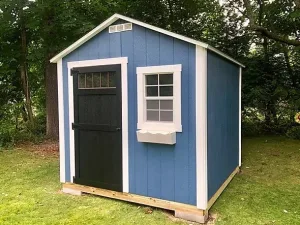
Conclusion
To ensure your shed is ready for its purpose, consider all the steps and factors discussed. Start by asking yourself why you’re getting a shed in the first place, followed by thinking about location, budgeting, size, permits, foundation materials, roofing, siding materials, flooring, door placement, insulation, and ventilation levels.
